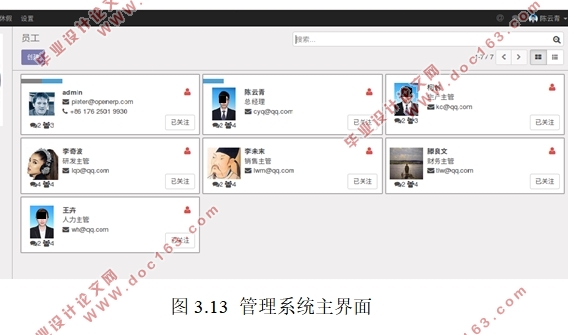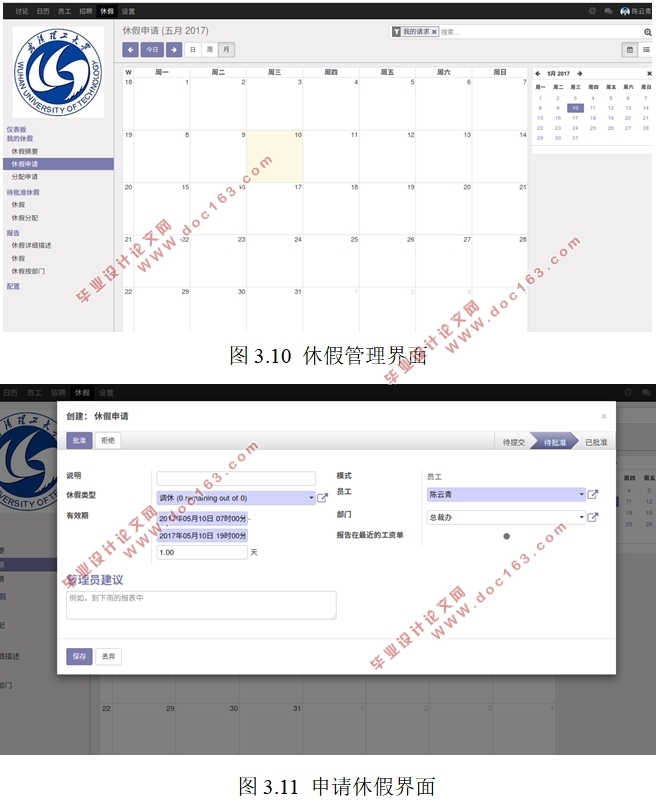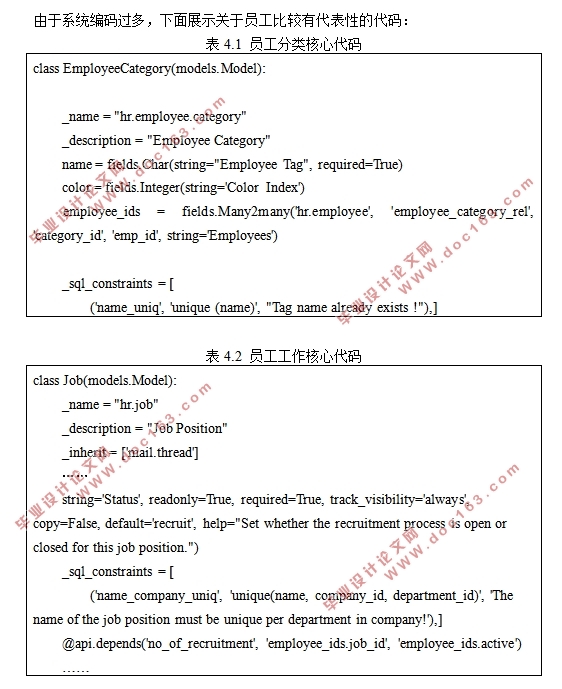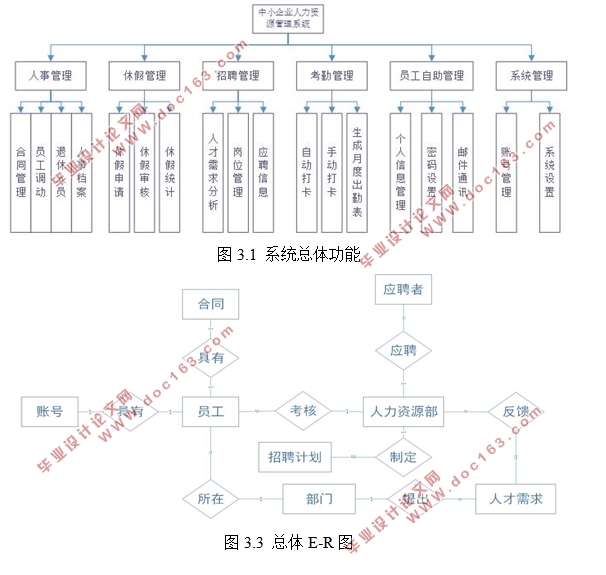中小型企业人力资源管理系统的设计(Python)

1.无需注册登录,支付后按照提示操作即可获取该资料.
2.资料以网页介绍的为准,下载后不会有水印.资料仅供学习参考之用.
密 惠 保
中小型企业人力资源管理系统的设计(Python)(任务书,开题报告,论文13000字,参考代码)
摘 要
近几年,伴随着经济的飞速发展和创业的浪潮,中小型企业的数量呈爆炸式增长,从16年国家统计数据来看,中小企业的数量往往都占据了各省企业的95%以上,甚至有达到99%。但传统中小型企业的人力资源管理往往比较滞后,管理仍停留在简单的员工查询、统计等,虽然可以满足一些基本的需求,但是专业性不够强,缺少相应的人事招聘、考核等一系列功能。新型创业型中小企业往往不注重人力资源的管理,人力资源管理部门人员往往紧缺,一个人需要承担多项职责,工作压力大。
针对上述问题,本文结合实际,考虑中小型企业的实际问题和需求,在传统人力资源管理的基础上,进行深入的分析研究,加入现代人力资源管理所必需的招聘考核、部门员工、日程安排、手动/上级签到等一系列功能。
在本文设计的人力资源管理系统中,每个员工都拥有自己的对应角色和账号,配以相应的操作界面和权限,并在管理日志中添加相应的管理日志,对于追究原委具有重大意义。
根据需求分析,本系统选择B/S结构,使用PostgreSQL开源数据库,使用Python2.7编程语言,于Windows系统中安装VMware虚拟机中建立Ubuntu 14.04系统进行开发与设计。 [版权所有:http://think58.com]
关键字:中小型企业,人力资源管理系统,B/S架构,数据库
Abstract
In recent years, along with the rapid development of economy and the wave of entrepreneurship, the number of small and medium-sized enterprise has exploded. The number of small and medium-sized enterprises tend to occupy more than 95% of the provincial enterprises, even has reached to 99%, through national statistics of 16 years. But the traditional human resource management of small and medium enterprises often lags behind, the management is still at low level of ability, such as simple staff queries, statistics and so on. While it is possible to meet the needs of some basic, but professional is not enough. Which is lack of corresponding personnel recruitment, assessment, and a series of functions. New entrepreneurial small and medium-sized enterprise often does not pay much attention to the management of human resources. Human resources management department personnel are often in short supply, who need to take a number of responsibilities and working pressure. [资料来源:http://think58.com]
According to the above problem, this paper combined with the actual, considering the practical problems and needs of small and medium-size enterprise. Taking traditional human resource management into consideration, on the basis of in-depth analysis and research, I add necessary to modern human resources management recruitment examination, such as employees, schedule, manual/supervisor sign in and a series of functions.
In the human resources management system designed by this paper, every employee has its own corresponding roles and accounts, match with corresponding operation interface and permissions. What’s more, I add in the admin log management log, which shall be investigated for the story is of great significance.
According to the demand analysis, the system choose B/S structure, using PostgreSQL open-source database, using Python2.7 programming language, was established in Windows install VMware virtual machine with Ubuntu 14.04 system.
Keywords: small and medium enterprise, human resource management system, B/S architecture, database
设计内容与设计方法
人才是一个企业最重要的资源,企业的所有发展都依赖于人才。企业只有有了相应的人才储备,才可能顺利的发展下去。设计中小型企业的人力资源管理系统主要自足于企业的实际情况,针对各职能,设计了人才招聘及考核、人员流动、假期调配、日历日常等一系列情况设计出相应的系统功能,使得企业中各项行为功能都可以落实到系统中去。
在设计中,使用现如今比较便捷的B/S的结构(Browser/Server),这使得中小型企业不再需要安装复杂的客户端,只需要浏览服务器端的相应地址即可进入人力资源管理系统,这可以给用户提供更好的界面和操作平台。
系统基于人力资源管理的基础理论,采用Python2.7为编程语言,使用PostgreSQL为后台数据库,遵循系统开发的设计原则,实现人力资源管理的各个功能。
[资料来源:http://www.THINK58.com]




目 录
摘 要 I
ABSTRACT II
第1章 绪论 1
1.1 设计的目的及意义 1
1.2 国内外研究现状 1
1.2.1国外研究现状 1
1.2.1国内研究现状 1
1.3 设计内容与设计方法 2
第2章 系统分析 3
2.1 需求分析 3
2.1.1中小型人力资源管理系统的目标 3
2.1.2功能需求 3
2.2 可行性分析 4
2.2.1技术可行性分析 4
2.2.2经济可行性分析 4
2.2.3操作可行性分析 4
2.3 组织结构分析 5
2.4 业务流程分析 5
2.5 数据流程分析 6
2.6 数据字典 9
2.6.1 数据元素 9
2.6.2 数据流 10
2.6.3 数据存储 11
2.6.4处理过程 13
2.6.5外部实体 16
第3章 系统设计 17
3.1 系统总体设计 17
3.1.1 功能模块结构设计 17
3.1.2 物理配置方案设计 18
3.2 系统详细设计 20
3.2.1编码设计 20
3.2.2数据库设计 21
3.2.3 输入输出及界面设计 27
3.2.4 处理过程设计 30
第4章 系统实施 31
4.1 系统编程 31
4.2 系统调试 32
4.3 系统测试 32
4.3.1 系统测试计划的制定 32
4.3.2 系统测试用例的设计 33
4.3.3 系统测试计划的执行 33
4.3.4 缺陷管理与改错 35
结束语 36
参考文献 37
致谢 38 [来源:http://think58.com]
